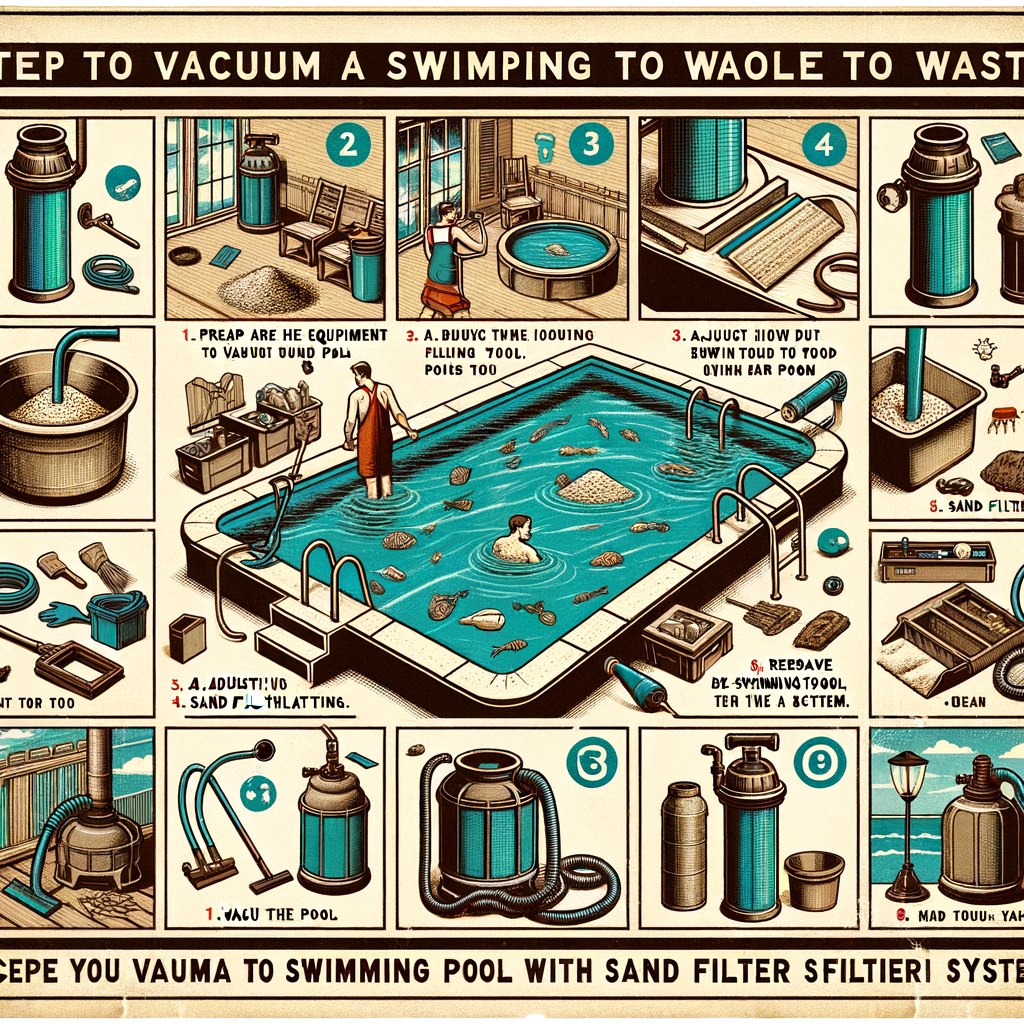
“Effortlessly Clear Your Pool: Master the Art of Vacuuming to Waste with a Sand Filter”
Table of Contents
Introduction
Vacuuming a pool to waste with a sand filter is an essential maintenance task that helps remove debris and contaminants from the pool water, ensuring a clean and safe swimming environment. This process involves bypassing the filter media and directly expelling the vacuumed water and debris out of the pool system, which is particularly useful when dealing with large amounts of dirt, algae, or other heavy contaminants that could clog the filter.
To effectively VACUUM a POOL to waste, it is important to follow a systematic approach that includes preparing the pool and equipment, setting the multiport valve to the correct position, and carefully managing the vacuuming process to avoid water loss and ensure thorough cleaning. This guide will provide step-by-step instructions on how to VACUUM a POOL to waste using a sand filter, ensuring optimal results and maintaining the pool’s cleanliness and hygiene.
Benefits of Vacuuming a Pool to Waste with a Sand Filter: A Comprehensive Overview

Vacuuming a pool to waste with a sand filter is a crucial maintenance task that offers numerous benefits, ensuring the pool remains clean and safe for use. This method involves bypassing the filter media and directly expelling debris-laden water from the pool, which can be particularly advantageous in certain situations. Understanding the benefits of this process can help pool owners make informed decisions about their pool maintenance routines.
One of the primary benefits of vacuuming a pool to waste is the effective removal of large debris and contaminants. When a pool accumulates significant amounts of dirt, leaves, or algae, these materials can clog the sand filter, reducing its efficiency. By vacuuming to waste, these contaminants are directly expelled from the pool system, preventing them from entering and potentially clogging the filter. This not only ensures a cleaner pool but also extends the lifespan of the sand filter by reducing the frequency of backwashing and maintenance.
Moreover, vacuuming to waste is particularly beneficial during the initial stages of opening a pool after a period of inactivity, such as after winter. Pools that have been closed for an extended period often contain a high concentration of debris and organic matter. Vacuuming to waste allows for the rapid and thorough removal of these contaminants, facilitating a quicker and more efficient pool opening process. This method is also advantageous when dealing with severe algae blooms, as it prevents the algae from circulating back into the pool through the filter system.
In addition to improving water quality, vacuuming to waste can help manage water chemistry more effectively. When debris and contaminants are removed directly from the pool, there is less organic matter to decompose and affect the chemical balance of the water. This can result in more stable pH levels and reduced demand for sanitizing chemicals, ultimately leading to cost savings on pool maintenance products. Furthermore, by preventing the reintroduction of contaminants into the pool, vacuuming to waste can reduce the likelihood of recurring water quality issues, such as cloudy water or persistent algae growth.
Another significant benefit of vacuuming to waste is the prevention of filter overload. Sand filters are designed to trap and hold a certain amount of debris before requiring backwashing. However, when faced with an excessive amount of debris, the filter can become overwhelmed, leading to reduced filtration efficiency and increased pressure within the system. By vacuuming to waste, pool owners can avoid this scenario, ensuring that the filter operates at optimal efficiency and reducing the risk of damage to the filtration system.
Additionally, vacuuming to waste can be a time-saving measure. Traditional vacuuming methods that rely on the filter can be time-consuming, especially when dealing with a heavily contaminated pool. By bypassing the filter and expelling debris directly, the cleaning process can be completed more quickly and with less effort. This allows pool owners to spend more time enjoying their pool rather than maintaining it.
In conclusion, vacuuming a pool to waste with a sand filter offers numerous benefits, including effective debris removal, improved water quality, better water chemistry management, prevention of filter overload, and time savings. By understanding and utilizing this method, pool owners can ensure their pools remain clean, safe, and enjoyable throughout the swimming season.
Common Mistakes to Avoid When Vacuuming a Pool to Waste with a Sand Filter
When vacuuming a pool to waste with a sand filter, it is crucial to avoid common mistakes that can compromise the efficiency of the process and potentially damage your pool equipment. One frequent error is neglecting to check the water level before starting. Vacuuming to waste involves removing water from the pool, so it is essential to ensure that the water level is sufficiently high to prevent the pump from running dry. Running the pump without adequate water can cause severe damage to the pump and filter system.
Another common mistake is failing to properly set the multiport valve. The multiport valve must be set to the “waste” position to ensure that the debris and water are directed out of the pool system and not back into the pool. Incorrectly setting the valve can result in recirculating dirty water, which defeats the purpose of vacuuming to waste. Additionally, it is important to turn off the pump before changing the valve position to avoid damaging the valve and other components.
Using the wrong vacuum head or hose can also lead to inefficiencies. A vacuum head designed for vinyl pools should not be used on concrete pools and vice versa. Using the appropriate equipment ensures that the vacuum head maintains proper contact with the pool surface, effectively removing debris. Similarly, ensuring that the vacuum hose is free of air pockets is vital. Air pockets can cause the pump to lose prime, reducing suction power and making the vacuuming process less effective.

Moreover, overlooking the importance of a clean skimmer basket and pump strainer can hinder the vacuuming process. These components should be checked and cleaned before starting to ensure optimal water flow. A clogged skimmer basket or pump strainer can reduce suction and strain the pump, leading to potential damage and decreased efficiency.
Another pitfall to avoid is vacuuming too quickly. Moving the vacuum head too fast can stir up debris, making it more difficult to remove. A slow and steady pace allows the vacuum to effectively pick up debris without causing it to become suspended in the water. Patience is key to ensuring a thorough cleaning.
Furthermore, it is essential to monitor the filter pressure gauge during the vacuuming process. A significant increase in pressure indicates that the filter is becoming clogged with debris. If this occurs, it is necessary to stop vacuuming and backwash the filter to restore proper flow. Ignoring high pressure can lead to reduced suction and potential damage to the filter system.
Lastly, failing to properly dispose of the waste water can lead to environmental and legal issues. It is important to ensure that the waste water is directed to an appropriate drainage area, away from storm drains and natural water bodies. Some regions have specific regulations regarding pool water disposal, so it is advisable to check local guidelines to ensure compliance.
In conclusion, vacuuming a pool to waste with a sand filter requires careful attention to detail and adherence to proper procedures. By avoiding these common mistakes, you can ensure an efficient and effective cleaning process, maintaining the health and clarity of your pool while protecting your equipment from unnecessary damage.
Essential Tips for Efficiently Vacuuming a Pool to Waste Using a Sand Filter
Vacuuming a pool to waste using a sand filter is an essential maintenance task that ensures the cleanliness and clarity of your pool water. This process is particularly useful when dealing with large amounts of debris, algae, or other contaminants that cannot be effectively removed through regular filtration. To achieve optimal results, it is crucial to follow a systematic approach and adhere to best practices. Here are some essential tips for efficiently vacuuming a pool to waste using a sand filter.
First and foremost, it is important to understand the function of the “waste” setting on your sand filter. This setting allows water to bypass the filter media and be expelled directly out of the pool system, taking with it any debris that has been vacuumed. This method is highly effective for removing large particles and contaminants that would otherwise clog the filter. Before beginning the vacuuming process, ensure that your pool’s water level is sufficiently high, as vacuuming to waste will result in a significant loss of water.
To start, gather all necessary equipment, including a vacuum head, telescopic pole, vacuum hose, and a waste hose. Attach the vacuum head to the telescopic pole and connect the vacuum hose to the vacuum head. Submerge the vacuum head and hose in the pool, allowing the hose to fill with water to prevent air from entering the system. Once the hose is filled, connect the other end to the skimmer or dedicated vacuum port.
Next, turn off the pool pump to avoid any damage during the setup process. Rotate the multiport valve on your sand filter to the “waste” position. This step is critical, as it ensures that the water and debris will be directed out of the pool system rather than passing through the filter media. After setting the valve to “waste,” turn the pump back on.
Begin vacuuming the pool by slowly moving the vacuum head across the pool floor. It is essential to move at a deliberate pace to ensure that all debris is effectively captured and expelled. Avoid rushing, as this can stir up debris and make it more difficult to remove. Pay special attention to areas with heavy contamination, such as corners and steps, where debris tends to accumulate.
Throughout the vacuuming process, monitor the water level in the pool. As water is expelled to waste, the level will drop, and it is important to maintain an adequate level to prevent damage to the pump and other equipment. If necessary, add water to the pool periodically to compensate for the loss.
Once you have thoroughly vacuumed the pool, turn off the pump and return the multiport valve to the “filter” position. This step is crucial to resume normal filtration and circulation of the pool water. After resetting the valve, turn the pump back on and check for any remaining debris. If needed, perform a final sweep with the vacuum to ensure that the pool is completely clean.
In conclusion, vacuuming a pool to waste using a sand filter is an effective method for removing large amounts of debris and contaminants. By following these essential tips and maintaining a systematic approach, you can ensure that your pool remains clean and inviting. Remember to monitor the water level, move the vacuum head slowly, and reset the multiport valve to the “filter” position once the task is complete. With these practices in place, you can efficiently maintain the cleanliness and clarity of your pool water.
Step-by-Step Guide to Vacuum a Pool to Waste with a Sand Filter
Vacuuming a pool to waste with a sand filter is an essential maintenance task that helps to remove debris and contaminants from the pool water, ensuring a clean and safe swimming environment. This process involves bypassing the filter media and directing the water and debris out of the pool system entirely. To begin, it is crucial to gather all necessary equipment, including a vacuum head, a telescopic pole, a vacuum hose, and a waste hose. Ensuring that all equipment is in good working condition will facilitate a smooth and efficient cleaning process.
First, attach the vacuum head to the telescopic pole, and then connect one end of the vacuum hose to the vacuum head. Submerge the vacuum head and hose into the pool, allowing the hose to fill with water. This step is vital to prevent air from entering the system, which could cause a loss of suction. Once the hose is filled with water, connect the other end to the skimmer or dedicated suction port. It is important to ensure a secure connection to maintain optimal suction power.
Next, turn off the pool pump to avoid any potential damage during the setup process. Locate the multiport valve on the sand filter, which typically has several settings, including filter, backwash, rinse, recirculate, and waste. Rotate the valve handle to the “waste” position. This setting will direct the water and debris out of the pool system, bypassing the filter media. It is essential to handle the valve with care to avoid damaging the internal components.
After setting the valve to “waste,” turn the pool pump back on. The pump will now draw water through the vacuum head, carrying debris and contaminants out of the pool and expelling them through the waste hose. It is advisable to monitor the water level in the pool during this process, as vacuuming to waste can significantly lower the water level. If necessary, add water to the pool to maintain an appropriate level and prevent damage to the pump.
Begin vacuuming the pool by moving the vacuum head slowly and methodically across the pool floor. Overlapping each pass will ensure thorough cleaning and prevent debris from being left behind. Pay particular attention to areas with heavy debris accumulation, such as corners and steps. It is important to maintain a steady pace to avoid stirring up debris, which can make the cleaning process more challenging.
Once the entire pool has been vacuumed, turn off the pool pump and disconnect the vacuum hose from the skimmer or suction port. Remove the vacuum head and hose from the pool, and store them properly for future use. Return the multiport valve to the “filter” position, and turn the pump back on to resume normal filtration.
Finally, it is essential to check the pool’s water chemistry and make any necessary adjustments. Vacuuming to waste can alter the chemical balance, so testing and balancing the water will help maintain a safe and comfortable swimming environment. Regular maintenance, including vacuuming to waste, will prolong the life of the pool equipment and ensure a clean and inviting pool for all to enjoy.
Q&A
1. **Question:** What equipment is needed to VACUUM a POOL to waste with a sand filter?
**Answer:** A pool vacuum head, a telescopic pole, a vacuum hose, and a multiport valve sand filter.
2. **Question:** What is the first step in vacuuming a pool to waste with a sand filter?
**Answer:** Turn off the pool pump and set the multiport valve to the “Waste” position.
3. **Question:** How do you connect the vacuum for the process?
**Answer:** Attach the vacuum head to the telescopic pole, connect the vacuum hose to the vacuum head, and then submerge the vacuum head and hose to fill the hose with water, ensuring no air is trapped.
4. **Question:** What should you do after vacuuming the pool to waste?
**Answer:** Turn off the pool pump, disconnect the vacuum equipment, and return the multiport valve to the “Filter” position before restarting the pump.
Conclusion
To VACUUM a POOL to waste with a sand filter, follow these steps:
1. Turn off the pool pump.
2. Set the multiport valve to the “Waste” position.
3. Attach the vacuum head to the telescopic pole and connect the vacuum hose.
4. Submerge the vacuum head and hose to fill with water, removing air.
5. Connect the hose to the skimmer or dedicated suction port.
6. Turn on the pool pump.
7. Vacuum the pool, moving slowly to avoid stirring up debris.
8. Monitor the water level and add water as needed to prevent the pump from running dry.
9. Once finished, turn off the pump.
10. Set the multiport valve back to the “Filter” position.
11. Turn on the pump and resume normal operation.
Conclusion: Vacuuming a pool to waste with a sand filter involves setting the multiport valve to “Waste,” connecting the vacuum equipment, and carefully vacuuming the pool while monitoring the water level. This method effectively removes debris directly out of the pool system, preventing it from clogging the filter.

